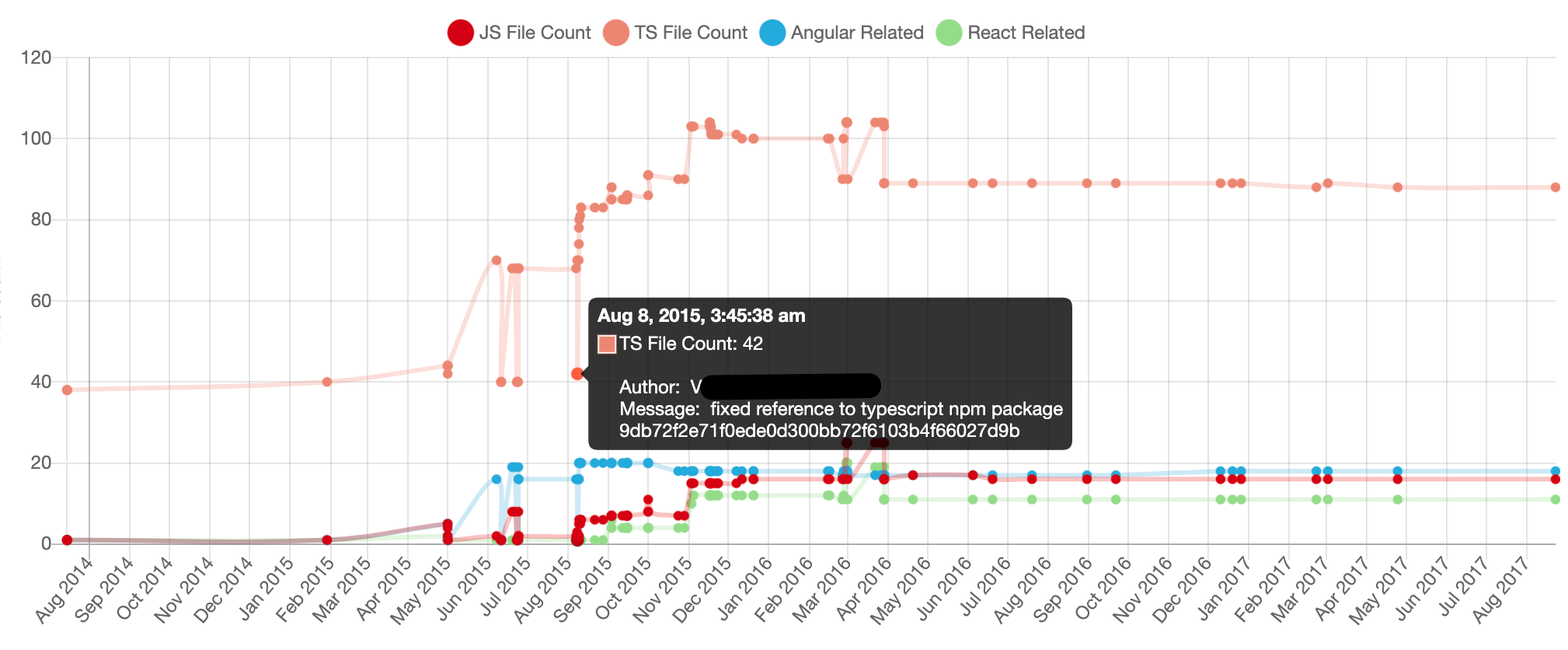git-metric v0.1.7
Git Metric
Git Metric is a tool for tracking file-based metrics in a git repository. Git Metric is ideal for projects with an ongoing incremental migration, for example:
- Migrating from AngularJS to React
- Migrating from JavaScript to TypeScript
- Any incremental removal of an old library or framework
Git Metric provides commit-based metrics, which can be easily displayed on a chart to provide meaningful insights.
See below the output of the example usage, which analyzes the TypeScriptSamples repository. The chart shows the number of JS, TS, Angular-related and React-related files for each commit in the repository.

Git Metric is extremely fast, and can be used with projects with various sizes and ages. Please note: if you need to collect metrics which depends on more than just the files content (like code coverage or complitation warnings), this tool can't help you.
How it works
When used, Git Metric will:
- Fetch the repository's commits the git history using gitlog.
- Calculate the metrics for each commit using git ls-tree and git grep.
Git Metric is written in TypeScript, and supplies d.ts files for you convenience.
Installation
npm install git-metricUsage
import gitMetric from 'gitMetric';
gitMetric.run({
repositoryPath: '/full/path/to/repo',
trackByFileExtension: { // Tracks a metric by the file extension
'Extension Metric 1': ['glob1', 'glob2'], // Each extension metric secifies the globs to look for
// For example:
'JS File Count': ['**.js', '**.jsx'],
'TS File Count': ['**.ts', '**.tsx'],
},
trackByFileContent: { // Tracks a metric by the file's content
'Content Metric 1': { // Each file content metric specifies the file globs and the phrase to look for in each file:
globs: ['glob10', 'glob20',],
phrase: 'some_phrase',
},
// For example:
'React Related': {
globs: ['**.js', '**.jsx', '**.ts', '**.tsx'],
phrase: 'react'
},
},
commitsSince: '1-15-2010', //MM-DD-YYYY
commitsUntil: '11-18-2021', //MM-DD-YYYY
maxCommitsCount: 450,
}).then(commitsWithMetrics => {
// Resolves with details about each commit, along with its metric. See below.
})run() resolves with an array of commits with metrics. Each element in the result contains two properties:
1. metrics - a map between a configured metric, and its value for this commit. A result for the configuration from the usage example will look like the following:
{
'Extension Metric 1': 23
'JS File Count': 174,
'TS File Count': 320,
}commit- additional details about the commit:hash,authorName,subject,authorDate,authorEmail,filesandstatus. The details are provided by gitlog.
Psst.. If you only want a one-time analyze of your project, you can just adjust the example code for your need.
Running the Example
- Clone the repo -
git clone https://github.com/omril321/git-metric.git cd git-metric/examplenpm installnpm start- Open the link on the console to view the chart
Contributing
If you wish to contribute, please contact me at any way. I'd be happy to work with you :)